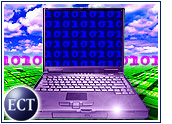A team of University of California at Los Angeles (UCLA) scientists said Thursday they have come up with a microscopic switch that will speed development of cheap and super-efficient “molecular machines” that could eventually replace computers.
“A molecular computer will enable us to do things we cannot even imagine now,” said UCLA’s James Heath.
Tiny Motors
Earlier this month, a team of researchers at Bell Laboratories and Oxford University made molecular-sized motors out of DNA so small that 30 trillion of them could fit into a single drop of water. The technology, called nanotechnology, is still in its infancy, but researchers have high hopes for its potential.
Scientists previously had developed a molecular switch that could only be used once and only in low temperatures. Thursday’s announcement from UCLA describes a switch that can be used repeatedly and at room temperature.
The new discovery involves a molecule called a catenane, made up of two interlocked rings consisting of atoms linked in a circle. Each ring contains two structures called “recognition sites” that react electrochemically when stimulated by electricity or light.
When activated, one electron is removed, causing one ring to rotate or flip around the other, turning the switch on. The switch is turned off when an electron is put back by activating it again. The fact it can be activated by either electricity or light means that optical computing is a distinct possibility.
Giant Competitors
Nanotechnology is a highly competitive experimental field with both private sector and government-sponsored funding. The UCLA study is being carried out in cooperation with Hewlett-Packard and is one of six projects being funded by the U.S. Defense Advanced Research Projects.
IBM, Motorola and Hewlett-Packard are among those experimenting with molecular electronics. Also, the Clinton administration earlier this year embarked on a program to spend almost $500 million a year (US$) on nanotechnology.
Bacterial Circuits
Thursday’s announcement is the latest in a series of extraordinary breakthroughs in experimental computer design. After experiments at Yale and Rice paved the way, researchers at MIT are reportedly having success in trying to exploit the common E. Coli bacteria for use as an electronic circuit capable of reproducing itself.
MIT is also experimenting with mapping circuitry on biological material, which means living cells could someday function as digital circuits.
Many observers and scientists believe that today’s computers chips, which are made by etching circuits on silicon with light, will be made obsolete by new molecular and biological technologies. Scientists believe that after the time comes when it is not possible to etch circuits any closer together on silicon, nanotechnology will take the lead.
Efficient Chemical Reactions
According to some researchers, in the future, billions of molecular circuits will be able to assemble themselves by chemical reaction, which would be far less costly and “a million times” more efficient than silicon-based computers. These circuits would be able to hold and store data more reliably and safely than today’s machines.
The circuits would also be so small, they could be used in a variety of ways: such as being woven into clothing, for example, or being used as tiny “robots” in the bloodstream to repair injuries.
With the latest advances in motors and switches, scientists are now looking to come up with the “wires” as well as the overall architecture to bind the systems together. For example, researchers are currently experimenting with long, thin tubes made of pure carbon, called carbon nanotubes.









































Social Media
See all Social Media